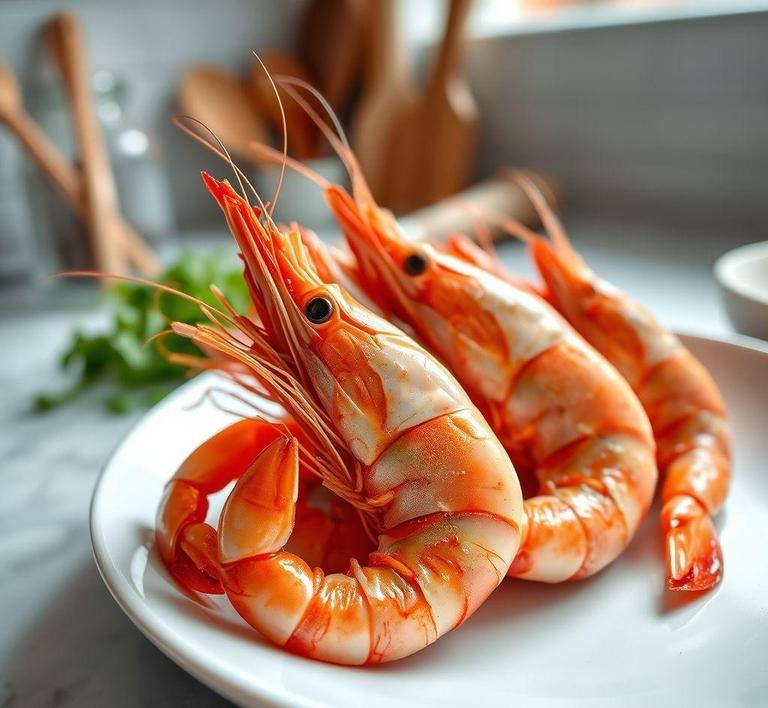Refreezing uncooked prawns can be a bit tricky, but with the right techniques, you can preserve their quality and enjoy them later without compromising on taste or texture. Whether you’ve bought too many prawns or just need to store leftovers, it’s important to understand the best practices to ensure they stay fresh and safe to eat. This guide will walk you through the dos and don’ts of refreezing uncooked prawns, including tips on how to properly store them, what to look out for to avoid freezer burn, and the best ways to thaw them for maximum flavor when you’re ready to cook.
Can You Refreeze Uncooked Prawns?

The short answer is: yes, you can refreeze uncooked prawns – but with significant caveats. Like many delicate seafoods, prawns are highly perishable and extremely sensitive to temperature fluctuations. Whether you’re dealing with tiger prawns, king prawns, or smaller varieties, the safety of refreezing them depends on one critical factor: how the prawns were thawed in the first place.
If you thawed your prawns in the refrigerator at a safe, consistent temperature of 0-4°C (32-39°F), they can be safely refrozen. This slow thawing method ensures that the prawns remained within a safe temperature zone that inhibits bacterial growth. However, if you defrosted them at room temperature, in warm water, or in the microwave, refreezing is not recommended due to the risk of microbial contamination.
Furthermore, it’s important to consider that each freeze-thaw cycle affects the texture and quality of the prawns. They are comprised largely of protein and water, making them particularly prone to cellular damage when frozen and thawed repeatedly.
How To Refreeze Uncooked Prawns?
If you’ve determined that your prawns were safely thawed in the refrigerator, you can proceed to refreeze them with care. Here’s a step-by-step guide to ensure maximum food safety and preservation of quality:
-
Inspect for Freshness:
Before refreezing, examine the prawns. They should appear translucent, firm, and have a mild, oceanic aroma. If they feel mushy, emit an ammonia-like smell, or appear slimy, discard them immediately.
-
Dry the Prawns:
Pat the prawns dry with paper towels. Excess moisture on the surface can lead to ice crystal formation during freezing, which further degrades the texture.
-
Portion Properly:
Divide the prawns into portion-sized containers or freezer-safe zip-lock bags. This prevents the need for future thawing and refreezing.
-
Use Freezer-Safe Packaging:
Place the prawns in airtight packaging. Remove as much air as possible to prevent freezer burn. Vacuum sealing is ideal, but pressing out air from zip-lock bags also works.
-
Label Clearly:
Mark each package with the date of refreezing. This helps track their freshness and ensures they are used within a safe time frame – ideally within 1 to 2 months for best quality.
-
Freeze Rapidly:
Place the packaged prawns in the coldest part of your freezer (typically at the back or bottom) to freeze them quickly. Rapid freezing reduces the size of ice crystals and helps maintain texture.
Quality Impact
While refreezing prawns is possible from a safety standpoint (under strict conditions), the culinary consequences cannot be ignored. Seafood, particularly shellfish like prawns, suffers more from freeze-thaw cycles than many other proteins.
Texture:
The largest quality concern when refreezing uncooked prawns is the texture. Each time the prawns thaw, ice crystals that formed during freezing melt and rupture the delicate muscle fibers. As a result, refrozen prawns may become soft, mushy, or mealy upon cooking – a far cry from the tender snap you expect in a stir-fry or paella.
Flavor:
Although prawns don’t lose much flavor from one refreeze cycle, subtle nuances – especially sweetness and briny freshness – can be dulled. Oxidation may also contribute to a slightly stale or off taste if they were not stored airtight.
Appearance:
Repeated freezing may result in discoloration – particularly if the prawns were not properly sealed. You may notice white patches (a sign of freezer burn) or uneven color tones, which although not harmful, are unappealing.
Moisture Loss:
Because freezing and thawing disrupt the cellular structure, prawns will release more water during cooking. This can affect the consistency of sauces and make it difficult to achieve a good sear.
Refreezing uncooked prawns is not without risk, but when done correctly and under stringent conditions, it is a safe option. The key is always temperature control – prawns must have been thawed in the refrigerator and not left out at room temperature. Equally important is how they are packaged, handled, and how quickly they are refrozen.
Still, even with perfect handling, there will likely be a drop in quality. Expect a change in texture and slight degradation in taste. For dishes where prawns are the centerpiece – such as shrimp scampi or grilled prawn skewers – the drop in quality may be more noticeable. However, in stews, curries, or fried rice, the textural changes might be masked enough to go unnoticed.
Whenever possible, plan ahead and freeze prawns in portioned batches to avoid having to refreeze. But if you’re faced with excess, rest assured that refreezing is a viable option – so long as it’s done with knowledge, care, and prompt action.
Let the freezer be your ally, not your enemy.
Is It Safe To Refreeze Uncooked Prawns?
The safety of refreezing uncooked prawns largely hinges on one critical factor: how they were handled between the initial thaw and the decision to refreeze. If the prawns were thawed in the refrigerator and kept below 4°C (39°F), then refreezing them is generally considered safe. This controlled, cold environment inhibits bacterial growth, ensuring the prawns remain in a food-safe state.
However, if prawns were thawed at room temperature or left out on a kitchen counter for more than two hours, refreezing becomes risky. At room temperature, bacteria like Vibrio and Listeria can multiply rapidly, potentially leading to foodborne illnesses. Refreezing in this scenario doesn’t kill the bacteria-it merely pauses their growth until the next thaw.
Refreezing also impacts the quality of the prawns. Every freeze-thaw cycle breaks down the cellular structure of the seafood, leading to texture degradation. Refrozen prawns may become mushy or watery when cooked, which can negatively affect the culinary experience.
In summary: Yes, it’s safe to refreeze uncooked prawns if they were defrosted properly in the fridge and haven’t exceeded safe time-temperature limits. Always use your senses and err on the side of caution.
Signs That Uncooked Prawns Should Not Be Refrozen
Before refreezing, inspect the prawns carefully for any signs of spoilage. The following are telltale indicators that they’ve gone bad and should not be refrozen-or consumed at all:
-
Unpleasant Odor:
Fresh prawns should have a neutral or slightly salty ocean-like scent. If they emit a strong, sour, or ammonia-like smell, it’s a clear sign of bacterial breakdown.
-
Discoloration:
Fresh prawns typically have a translucent gray or bluish hue. If you notice any yellowing, black spots, or pinkish tints (unless they’re meant to be pink, as with pre-cooked prawns), it may suggest spoilage or oxidation.
-
Slimy Texture:
While prawns should feel firm and slightly moist, a slimy coating is a red flag. This slippery layer often indicates bacterial growth and decomposition.
-
Soft or Mushy Flesh:
If the prawns feel unusually soft or fall apart under gentle pressure, the tissue may have begun to break down due to improper thawing or extended exposure to heat.
If any of these signs are present, do not refreeze-or cook-the prawns. Discard them immediately to avoid the risk of foodborne illness.
Common Refreezing Mistakes
Refreezing seafood like prawns is a practice that demands precision and care. Unfortunately, many people unknowingly make critical mistakes that compromise both safety and quality:
-
Refreezing After Room-Temperature Thawing:
As mentioned earlier, leaving prawns out on the counter to thaw is dangerous. Bacteria proliferate quickly at ambient temperatures, and refreezing at this stage won’t make them safe again.
-
Long Exposure Before Refreezing:
Even if prawns are thawed in the fridge, leaving them for too long (over 24-48 hours) before refreezing is ill-advised. During this time, enzymes and microbes can multiply and degrade both safety and flavor.
-
Repeated Refreezing:
Each cycle of thawing and freezing damages the prawn’s structure, turning firm flesh into a soft, watery mess. Repeated refreezing dramatically lowers the food’s appeal and potentially increases risk.
-
Using Non-Airtight Packaging:
Exposing prawns to freezer air without proper sealing results in freezer burn-those telltale white patches of dehydrated meat. Freezer burn ruins taste and texture, making prawns tough and unpalatable.
-
Failing to Label and Date:
Not noting when you first froze or thawed your prawns can lead to prolonged storage times and eventual food waste. Always mark containers with the date and contents for clarity.
🧠 Tips And Tricks For Safely Refreezing Prawns
If you’re determined to refreeze prawns and maintain quality and safety, these expert-approved tips will guide your process:
-
Use the Refrigerator for Thawing:
Always thaw prawns in the refrigerator. This slow, cold method preserves freshness and drastically reduces bacterial risk.
-
Freeze in Small Portions:
Divide prawns into smaller, meal-sized portions before freezing. This reduces the need to thaw large batches you may not use all at once, helping you avoid waste and refreezing scenarios.
-
Vacuum Seal or Wrap Tightly:
To prevent freezer burn and flavor loss, seal prawns tightly in vacuum-sealed bags or wrap them in plastic wrap followed by a freezer-safe bag.
-
Freeze Immediately After Decision:
If you know you won’t use your thawed prawns soon, refreeze them as soon as possible-ideally within 24 hours of refrigeration. The less time they sit thawed, the better.
-
Label Everything:
Include the original freezing date, thawing date, and refreezing date if applicable. This ensures you consume them within the safe period (typically within 3-6 months for best quality).
-
Cook Thoroughly After Refreezing:
When it’s time to cook refrozen prawns, ensure they are thoroughly cooked to an internal temperature of 63°C (145°F). This will kill any lingering bacteria that may have developed.
Conclusion
Refreezing uncooked prawns is a nuanced practice that walks a fine line between convenience and safety. While it’s certainly possible to do safely, the outcome depends entirely on your handling methods. If prawns have been properly thawed in the fridge, kept cold, and show no signs of spoilage, refreezing them is a viable option. However, the quality may decline, and repeated thawing and freezing should be avoided.
By staying vigilant-checking for spoilage, avoiding common mistakes, and implementing smart freezing practices-you can ensure your prawns stay delicious and, most importantly, safe to eat. In the world of seafood, freshness is king, so when in doubt, throw it out. After all, no dish is worth a health risk.


